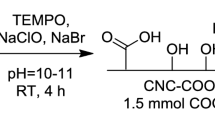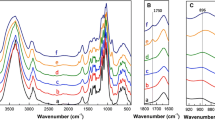Abstract
Cellulose nanocrystals (CNC) were functionalized in aqueous media at the reducing, aldehyde ends of cellulose. CNC oxidation to produce carboxyl groups was followed by carbodiimide-mediated reaction to install thiol groups. The selectivity and extent of thiolation at the reducing ends was qualitatively confirmed by imaging (transmission electron microscopy) silver nanoparticles that tagged the CNC termini and by X-ray photoelectron spectroscopy, respectively. The adsorption of thiolated CNC onto gold surfaces as well as the viscoelastic property of the formed adlayer was investigated by using quartz crystal microgravimetry. The thiolated CNC chemisorbed on the surfaces were further analyzed for surface density and distribution by using atomic force microscopy. Overall we introduce a facile, mild asymmetric thiolation procedure as an efficient alternative to conventional reductive amination.






Similar content being viewed by others
References
Arcot LR, Nykänen A, Seitsonen J, Johansson LS, Campbell J, Rojas OJ, Ikkala O, Laine J (2013) Cilia-mimetic hairy surfaces based on end-immobilized nanocellulose colloidal rods. Biomacromolecules 14(8):2807–2813
Castner DG, Hinds K, Grainger DW (1996) X-ray photoelectron spectroscopy sulfur 2p study of organic thiol and disulfide binding interactions with gold surfaces. Langmuir 12(21):5083–5086
Dixon MC (2008) Quartz crystal microbalance with dissipation monitoring: enabling real-time characterization of biological materials and their interactions. J Biomol Tech 19(3):151–158
Dong S, Roman M (2007) Fluorescently labeled cellulose nanocrystals for bioimaging applications. JACS 129(45):13810–13811
Eyley S, Thielemans W (2011) Imidazolium grafted cellulose nanocrystals for ion exchange applications. Chem Commun 47(14):4177–4179
Eyley S, Shariki S, Dale SEC, Bending S, Marken F, Thielemans W (2012) Ferrocene-decorated nanocrystalline cellulose with charge carrier mobility. Langmuir 28(16):6514–6519
Habibi Y, Lucia LA, Rojas OJ (2010) Cellulose nanocrystals: chemistry, self-assembly, and applications. Chem Rev 110:3479–3500
Hasani M, Cranston ED, Westman G, Gray DG (2008) Cationic surface functionalization of cellulose nanocrystals. Soft Matter 4(11):2238–2244
Hermanson GT (2008) Bioconjugate Techniques, 2nd edn. Academic press, Waltham
Hieta K, Kuga S, Usuda M (1984) Electron staining of reducing ends evidences a parallel-chain structure in Valonia cellulose. Biopolymers 23(10):1807–1810
Höök F, Rodahl M, Brzezinski P, Kasemo B (1998) Energy dissipation kinetics for protein and antibody-antigen adsorption under shear oscillation on a quartz crystal microbalance. Langmuir 14(4):729–734
Jackson J, Letchford K, Wasserman B, Ye L, Hamad W, Burt H (2011) The use of nanocrystalline cellulose for the binding and controlled release of drugs. Int J Nanomed 6:321–330
Jin H, Kettunen M, Laiho A, Pynnolnen H, Paltakari J, Marmur A, Ikkala O, Ras RHA (2011) Superhydrophobic and superoleophobic nanocellulose aerogel membranes as bioinspired cargo carriers on water and oil. Langmuir 27(5):1930–1934
Karaaslan MA, Gao G, Kadla JF (2013) Nanocrystalline cellulose/β-casein conjugated nanoparticles prepared by click chemistry. Cellulose 20(6):2655–2665
Kim J-H, Kang K, Yun S, Yang S, Lee M-H, Kim J-H, Kim J (2008) Cellulose electroactive paper (EAPap): the potential for a novel electronic material. MRS Proc. doi:10.1557/PROC-1129-V05-02
Kim J, Lee H, Kim HS (2010) Beam vibration control using cellulose-based electro-active paper sensor. Int J Precis Eng Manuf 11(6):823–827
Klemm D, Philipp B, Heinze T, Heinze U, Wagenknecht W (1998) Systematics of cellulose functionalization: comprehensive cellulose chemistry Wiley. KGaA: 1–31
Klemm D, Heublein B, Fink H, Bohn A (2005) Cellulose: fascinating biopolymer and sustainable raw material. Angew Chem Int Ed 44:3358–3393
Koyama M, Helbert W, Imai T, Sugiyama J, Henrissat B (1997) Parallel-up structure evidences the molecular directionality during biosynthesis of bacterial cellulose. PNAS 94(17):9091–9095
Lee SW, Kim JH, Kim J, Kim HS (2009) Characterization and sensor application of cellulose electro-active paper (EAPap). Chin Sci Bull 54:2703–2707
Li Y, Ragauskas AJ (2011) Cellulose nano whiskers as reinforcing filler in polyurethanes. Advances in diverse industrial application of nanocomposites. In: Boreddy R (ed) InTech:17–36
Lin N, Huang J, Dufresne A (2012) Preparation, properties and applications of polysaccharide nanocrystals in advanced functional nanomaterials: a review. Nanoscale 4(11):3274–3294
Littlejohn D, Chang S (1995) An XPS study of nitrogen–sulfur compounds. J Electron Spectrosc Relat Phenom 71(1):47–50
Love CJ, Estroff LA, Kriebel JK, Nuzzo RG, Whitesides GM (2005) Self-assembled monolayers of thiolates on metals as a form of nanotechnology. Chem Rev 105(4):1103–1169
Moon RJ, Ashlie M, Nairn J, Simonsen J, Youngblood J (2011) Cellulose nanomaterials review: structure, properties and nanocomposites. Chem Soc Rev 40(7):3941–3994
Nypelö T, Rodriguez Abreu C, Rivas J, Dickey MD, Rojas OJ (2014) Magneto-responsive hybrid materials based on cellulose nanocrystals. Cellulose. doi:10.1007/s10570-014-0307-2
Siow KS, Britcher L, Kumar S, Griesser HJ (2006) Plasma methods for the generation of chemically reactive surfaces for biomolecule immobilization and cell colonization: a review. Plasma Process Polym 3(6–7):392–418
Strother T, Hamers RJ, Smith LM (2000) Covalent attachment of oligodeoxyribonucleotides to amine-modified Si (001) surfaces. Nucleic Acids Res 28(18):3535
Velleste R, Teugjas H, Väljamäe P (2010) Reducing end-specific fluorescence labeled celluloses for cellulase mode of action. Cellulose 17(1):125–138
Wandowski T, Malinowski P, Ostachowicz WM (2011) Damage detection with concentrated configurations of piezoelectric transducers. Smart Mater Struct 20(2):025002–025016
Yun G, Kim J, Kim J, Kim S (2010) Fabrication and testing of cellulose EAPap actuators for haptic application. Sens Actuators A Phys 164:68–73
Zoppe JO, Habibi Y, Rojas OJ, Venditti RA, Johansson L, Efimenko K, Österberg M, Laine J (2010) Poly(N-isopropylacrylamide) brushes grafted from cellulose nanocrystals via surface-initiated single-electron transfer living radical polymerization. Biomacromolecules 11(10):2683–2691
Acknowledgments
The TEM images presented in this work were recorded at the Aalto University Nanomicroscopy Center (Aalto-NMC) premises. This work was partly supported by the Academy of Finland through its Centres of Excellence Programme (2014–2019) and under Project 132723612 HYBER.
Author information
Authors and Affiliations
Corresponding authors
Additional information
Lokanathan R. Arcot and Meri Lundahl have contributed equally to this work.
Rights and permissions
About this article
Cite this article
Arcot, L.R., Lundahl, M., Rojas, O.J. et al. Asymmetric cellulose nanocrystals: thiolation of reducing end groups via NHS–EDC coupling. Cellulose 21, 4209–4218 (2014). https://doi.org/10.1007/s10570-014-0426-9
Received:
Accepted:
Published:
Issue Date:
DOI: https://doi.org/10.1007/s10570-014-0426-9




